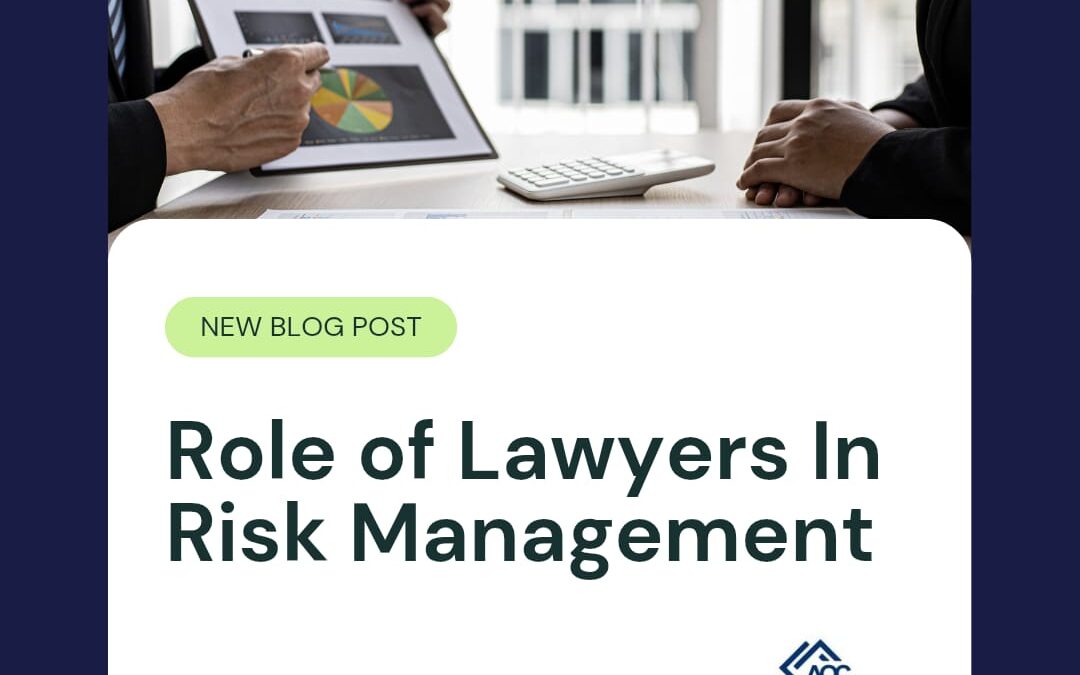Introduction
Risk is inherent in every human endeavor. From nascent startups to multinational conglomerates, organizations face an array of potential pitfalls and numerous challenges ranging from legal liabilities and regulatory non-compliance to reputational damage and operational disruptions.[1] Risk management, therefore, becomes essential to the sustainability and profitability of any organization. While risk managers are often considered in financial or operational terms, lawyers play an equally crucial and multifaceted role not only as legal advisors but also strategic partners who help businesses anticipate, assess, and mitigate legal and regulatory risks. Their expertise is essential not only in identifying and mitigating legal risks but also in integrating legal risk considerations into broader enterprise risk management (ERM) frameworks. Through deliberate planning and the proactive prevention of regulatory issues, businesses can obviate the likelihood of Legal liabilities, reputational damage, and financial losses. This article explores the critical roles lawyers play in risk management, highlighting their contributions to proactive risk identification, assessment and prevention.
WHAT IS RISK MANAGEMENT
Risk management involves anticipating potential threats to a business, taking proactive steps to mitigate challenges, reducing uncertainty, and developing strategies to prevent or minimize the impact of potential issues.[2]
Traditionally, the perception of lawyer’s role in risk management was largely confined to litigation, stepping in to minimize damage after a legal crisis erupted. However, this view is now outdated as contemporary legal practice embraces a proactive and comprehensive approach by integrating legal expertise into every stage of the risk management lifecycle.[3]
Lawyers integrate legal risk management by identifying potential legal issues that may arise from the organization’s operations, contracts, transactions, or regulatory interactions. Below are some of the roles of lawyers in risk management.
- Proactive Identification and Assessment
Lawyers are uniquely positioned to identify potential legal risks before they materialize, serving as a critical first line of defense in an organization’s risk management framework.[4] Their deep understanding of statutes, regulations, case law, and industry-specific compliance standards enables them to anticipate legal pitfalls that may not be immediately apparent to other professionals.
This proactive function goes beyond surface-level legal review. For instance, in contractual analysis, lawyers examine not only express terms but also implied obligations, jurisdictional clauses, and indemnity provisions that could expose the organization to future disputes or liability. In corporate transactions, they evaluate the legal feasibility of proposed ventures, flagging licensing issues, anti-trust concerns, or potential breaches of local and international laws.[5]
Lawyers play an essential role in policy vetting and internal controls. They assess employee handbooks, whistleblower mechanisms, privacy protocols, and data protection measures to ensure compliance with evolving regulatory landscapes. Their ability to interpret judicial trends also allows them to forecast how courts are likely to treat certain business practices or clauses in contracts, thereby helping organizations make informed decisions that reduce exposure to litigation and regulatory sanctions. By integrating legal risk assessments early in project planning, mergers, or new product development, lawyers help to embed a culture of compliance and foresight across the organization.[6]
- Risk Mitigation and Prevention
Once risks are identified, the next critical step in the risk management lifecycle is mitigation and prevention. At this stage, lawyers serve as strategic advisors and architects of the systems, structures, and safeguards that shield an organization from liability and regulatory infractions.[7] Their objective is not merely to respond to problems, but to proactively prevent them through well-considered legal design. This involves drafting ironclad contracts, establishing comprehensive compliance programs, developing robust data privacy policies, advising on intellectual property protection, or structuring corporate transactions to minimize legal liability. They help organizations build a strong legal foundation that can withstand scrutiny and construct a resilient legal framework that doesn’t just defend against legal threats but actively avoids them. By influencing policies, drafting documents, and educating stakeholders, Lawyers ensure that risk management is not a one-off activity but a fundamental part of the Organization’s culture and operation.[8]
- Policy Development and Training
Legal teams are integral to the development, implementation, and continuous refinement of an organization’s internal policies, procedures, and codes of conduct. Their involvement ensures that these policy frameworks are not only compliant with the current legal and regulatory standards but also tailored to the specific risk profile and operational realities of the organization.[9] From anti-corruption policies and data protection protocols to employment handbooks and whistleblower mechanisms, legal professionals draft policies that serve as both a compliance roadmap and a behavioral compass for the entire workforce.[10]
Beyond policy drafting, legal departments play a crucial role in translating complex legal requirements into practical, accessible guidance for employees across all levels. They lead regular training and awareness programs on critical legal and ethical issues such as anti-money laundering (AML), workplace harassment, insider trading, intellectual property, and conflict of interest management. These sessions are often tailored to the operational context of specific departments, ensuring relevance and practical applicability.
These trainings are not mere formalities but strategic tools for risk prevention. By equipping employees with knowledge of the laws and internal rules that govern their actions, legal teams foster a proactive compliance culture, one in which potential legal breaches are identified and addressed before they escalate into liabilities. This culture of awareness and accountability not only reduces the likelihood of infractions but enhances the organization’s reputation with regulators, clients, and the public.[11]
Furthermore, legal teams often incorporate feedback mechanisms, compliance checklists, and periodic assessments to evaluate the effectiveness of these policies and training programs. This iterative approach allows organizations to adapt to evolving legal landscapes and emerging risks, maintaining a dynamic compliance environment that is both resilient and responsive thereby embedding legal consciousness into the fabric of the organization, enabling it to function with integrity, efficiency, and foresight.
- Legal Consultation and Support
In today’s rapidly evolving legal and regulatory environment, businesses require legal consultation to remain compliant, competitive, and resilient. Business lawyers ensure that companies are not only reacting to legal developments but are also proactively adjusting their strategies to stay ahead of emerging legal trends and regulatory expectations. They work closely with management to align business objectives with legal compliance, identify regulatory risks before they materialize, and offer legal strategies for innovation and growth.[12]
Lawyers help to anticipate legal shifts that could affect business models, markets, or supply chains. Whether it’s the enactment of new data protection laws, changes in tax legislation, updates to labor codes, or shifts in international trade regulations, legal advisers help businesses forecast their impact and adapt accordingly. This ensures not just compliance but operational continuity and strategic agility. They respond to unexpected legal issues such as litigation threats, government audits, regulatory investigations, or contractual breaches.[13] They also swiftly assess risks, recommend remedial measures, engage with regulators, and manage communications to mitigate reputational harm.
Continuous legal consultation and support fosters consistency in compliance efforts across the organization as lawyers play a central role in reviewing key business processes such as procurement, advertising, employment practices, and customer engagement to ensure they are in line with legal standards. They also promote cross-functional collaboration, ensuring that legal compliance is seamlessly integrated into all aspects of the business rather than treated as a separate or isolated function.[14]
In conclusion, lawyers play a vital role in modern risk management by moving beyond crisis response to proactive prevention and strategic guidance. They help organizations identify legal risks, ensure compliance, support ethical decision-making, and enable growth within legal boundaries. By translating legal complexities into actionable strategies and ensuring that innovation is pursued within the bounds of the law, lawyers safeguard not only the legal standing of organizations but also their reputational and operational integrity. As businesses continue to navigate uncertainty, regulatory shifts, and digital transformation, the lawyer’s role as a risk manager will remain not only relevant but indispensable. Ultimately, effective risk management is not merely about avoiding pitfalls it is about enabling sustainable growth. And in this pursuit, lawyers are not just advisors they are architects of stability, trust, and strategic foresight.
[1] How can a business lawyer support your company’s compliance with state and federal Regulation, Purdy&Bailey. https://www.purdybailey.com/blog/2024/april/how-can-a-business-lawyer-support-your-companys-/ Accessed June 18, 2025
[2] D.Frolich, The Role of Business Attorneys in Risk Management. < https://www.dicksonlegal.com/the-role-of-business-attorneys-in-risk-management/> Accessed June 16, 2025
[3] The importance of risk management tools in legal practice, Legitquest. < https://www.legitquest.com/legal-guide/the-importance-of-risk-management-tools-in-legal-practice> Accessed June 18, 2025.
[4] Determining Your Company’s Legal Risk Tolerance, Squire Patton Boggs. <chrome-extension://efaidnbmnnnibpcajpcglclefindmkaj/https://www.squirepattonboggs.com/-/media/files/insights/publications/2018/12/our-perspectives/determining-your-companys-legal-risk-tolerance/op_determining_your_co_legal_risk.pdf> Accessed June 25, 2025.
[5] ibid
[6] A. Hall, Frameworks for assessing legal risk in board decision-making. < https://aaronhall.com/frameworks-for-assessing-legal-risks-in-board-decision-making/#Understanding_Legal_Risk_Assessment> Accessed June 25, 2025
[7] P.Kurer, The concept of strategic legal risk management and the role of lawyers. < https://lam.unisg.ch/en/knowhow/the-concept-of-strategic-legal-risk-management-and-the-role-of-lawyers> Accessed June 23, 2025
[8] K. Dunphy, The role of in-house lawyers in enterprise risk management. < https://www.diligent.com/en-au/resources/blog/the-role-of-in-house-legal-in-enterprise-risk-management> Accessed June 18, 2025
[9] ibid
[10] A.S. Gutterman, The Role of Law Department in Legal Risk Management. < https://store.legal.thomsonreuters.com/law-products/news-views/corporate-counsel/the-role-of-the-law-department-in-legal-risk-management> Accessed June 23, 2025
[11] ibid
[12] R. Ostrander, The Legal Function’s Role in the Risk Management Framework: Jack-of-All-Trades, Cog in the Machine, or Misfit Toy? < https://www.newyorkfed.org/newsevents/speeches/2024/ost240419> Accessed June 25, 2025
[13] ibid
[14] ibid


